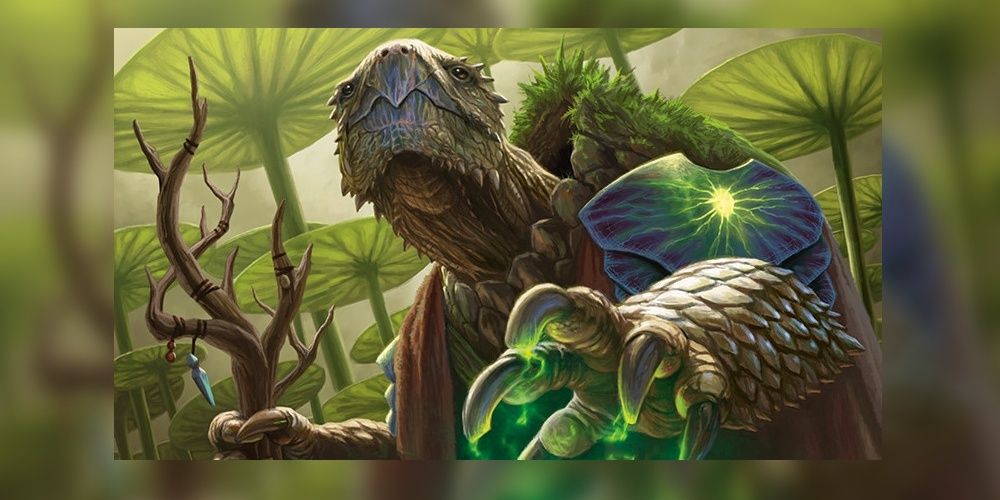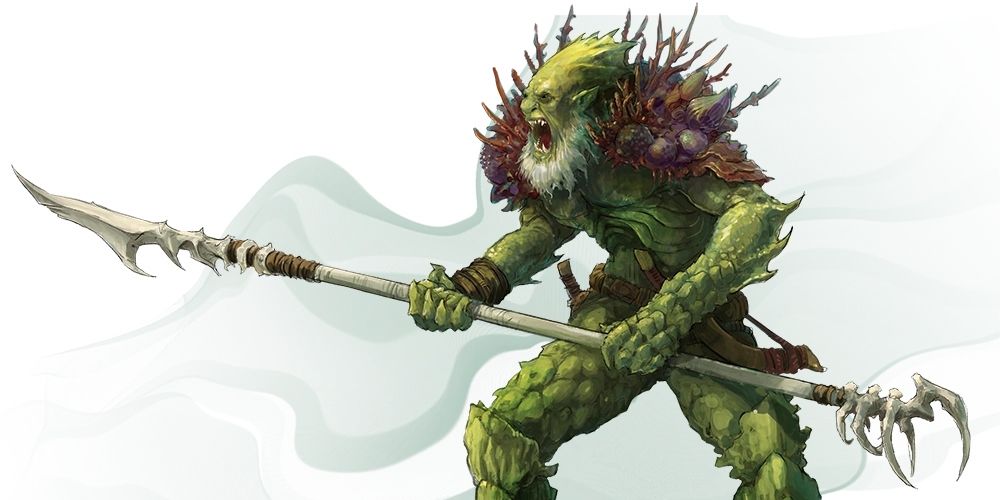[ad_1]
Dungeons & Dragons adventures can happen virtually anyplace, however adventures at sea are an evergreen favourite. Players and Dungeon Masters alike are virtually at all times eager to see ships set sail for distant ports, and these sorts of adventures typically function loads of time in coastal areas.
There are loads of monsters which are snug on land and many which are purely aquatic, however there are particular creatures which are completely at residence on the border between land and sea. These sorts of adventures are an incredible alternative to see a various array of D&D monsters, serving to so as to add to their recognition.
Updated August twenty ninth, 2022 by Isaac Williams: It’s good to have the ability to run a D&D journey in any biome, however some, such because the coast, can really feel underrepresented in official supplies. To assist DMs run coastal adventures, this listing has been up to date with much more monsters which are proper at residence on the water’s edge, striving to cowl as many stage ranges and varieties of journey as potential.
15 Sahuagin Are Amphibious Raiders
These fish-like creatures are known as sea devils by some coastal residents, as a result of their tendency to prey on seaside settlements. They have a blood frenzy potential that grants them benefit on melee assaults towards enemies which have taken any quantity of harm, which makes them a strong foe.
Some sahuagin take up spellcasting as darkish clerics, whereas others develop to immense sizes and rule as brutal barons. With their antagonistic relationship with delivery and coastal cities, sahuagin are apparent enemies for a celebration on the coast – however with extra complexity and selection than an incredible many monsters in Fifth Edition.
14 Merfolk And Merrow Dwell In The Deep
Merfolk are frequent in lots of mythologies all through the world, as they characterize a familiar-yet-alien entity. Merfolk may be good or evil identical to another sapient creature, that means they might simply be enemies or allies in a D&D journey set by the ocean.
Merrow, in contrast, are one thing far much less human. They are merfolk reworked by the corrupting nature of the demon lord Demogorgon. They’re malevolent and merciless creatures that may serve on their very own as a risk, or give the participant characters a cause to aspect with merfolk towards a standard foe.
13 Giant Sharks Suit Low-Level Coastal Adventurers
When in comparison with the sapient D&D creatures and monsters who inhabit the shallows, an even bigger model of one thing discovered on Earth can appear underwhelming. However, the large shark statblock for Fifth Edition is a remarkably highly effective and intimidating one, well-suited for a terrifying coastal monstrosity.
Whether a aspect encounter throughout one other journey, or the main focus of a Jaws-esque quest to make the coast safer, large sharks could make surprisingly harmful opponents for participant characters. For a much less fantastical coastal journey, they’re a stable selection.
12 Sea Hags Have Foul Magic
Hags are highly effective fey spellcasters, however sea hags are the weakest amongst them. Covered in slimy scales and draped in fetid seaweed, these creatures typically conceal their true nature with an illusory veil. They might strategy the adventurers as a pleasant or hostile face to kickstart a D&D journey.
Sea hags lack the spellcasting talents of their extra highly effective kinfolk, although they do boast the highly effective Death Glare potential which might cut back a goal to zero hit factors instantly. Sea hags, like all hags, can be part of collectively in a coven to realize entry to rather more highly effective talents, permitting for an appropriate end-of-adventure battle from seemingly weak creatures.
11 Fathomers Are Capable On The Coast Or On Land
Cults and cultists are ready-made villains for nearly any journey in D&D, and Ghosts of Saltmarsh ensures that there are some perfectly-suited for coastal adventures as nicely. Fathomers are spellcasting people who can flip into huge watery snakes because of pacts with historical evil, the perfect risk to catch gamers off-guard.
A serious boon of the fathomer is their versatility. They can simply menace the participant characters within the shallows, however they will additionally monitor, assault, or plot towards them on land. They’re much less restricted than different coastal creatures, whereas nonetheless becoming the atmosphere completely.
10 Tortles Are An Amphibious People
Although not the best-suited aquatic creatures, missing an innate swimming velocity, tortles can deal with themselves nicely by the coast. They have the flexibility to carry their breath for an hour, permitting them to perform naturally in areas the place different humanoid creatures would want to reinforce themselves with magic.
As such, a tortle or perhaps a band of them might nicely reside on the coast, exploring the murky depths past. Although they’re acknowledged to lean in the direction of lawful good as a race, there isn’t any cause participant characters could not come throughout an evil or felony group of them – and even merely discover themselves opposed by good or noble tortles.
9 Koalinths Are Coastal Hobgoblins
Quite a lot of coastal creatures are usually of the wild or cultish selection. with out a lot of an emphasis on order or techniques. Koalinths are very completely different, being aquatic variations of the basic D&D hobgoblin. Although they’re famous for his or her aggressive nature, they preserve the lawful leanings of their floor kin, as nicely a number of different traits.
If a DM will get inventive with the hobgoblin variants introduced all through varied books in 5e, koalinths can be utilized to create a singular martial risk to the gamers on the coast. In specific, they are often simpler to cause or negotiate with than most monsters, being a sapient and rational species.
8 Sea Spawn Are Fish-Like Mutants
Legends say that the ocean spawn are these misplaced sailors who by no means returned from their voyages. These creatures discover themselves drawn to highly effective monstrosities throughout the sea, appearing as their footsoldiers and servants ought to they be wanted.
Sea spawn develop to resemble varied sea creatures as they warp and alter, and have entry to highly effective chunk assaults, toxic quills, and long-reaching tentacles. Versatile and sometimes in league with better powers, they make good threats for low-level coastal campaigns, or good henchmen for greater ranges.
7 Wastriliths Are The Best Aquatic Demons
D&D‘s highly effective demons may be present in virtually any ecological area of interest, and wastriliths dominate the aquatic realms. They are able to fouling the water round them, whether or not it’s within the ocean or in containers. This foul water poisons anybody who swims in it or consumes it, whereas demons heal once they drink it.
In direct fight, wastriliths can combat with their vicious claws, create troublesome terrain by way of rippling undertows, and even launch spouts of caustic water to destroy their enemies. Adventurers combating them in coastal waters are at a terrain drawback, creating a singular dynamic for gamers who need to hunt them down.
6 Kraken Priests Worship The Horrors Of The Deep
Coastal adventures can typically function one part of – or a prelude to – a narrative arc or total marketing campaign happening throughout the deeper sea. Many of the ocean’s best threats are poorly-suited to the shallows, however that is not to say they cannot have heralds or servants who go there to provide the gamers an inkling of what they’re coping with.
Kraken clergymen are creatures who’ve turned to worshipping krakens out of concern and awe, and been given powers consequently. One or extra might simply journey to the coast to additional a kraken’s targets. This can introduce the PCs to a kraken villain with out placing them within the firing line of a monstrosity able to difficult max-level characters.
5 Deep Scions Are Deceitful Shapeshifters
These shapeshifters are created when determined, drowning troopers make offers with foul aquatic entities like krakens or marids of their dying moments. They return as foul, tentacled humanoids that work in secret to advance their grasp’s agendas.
Deep scions are highly effective, posing a risk on their very own to even D&D characters as much as about fifth stage. As nicely as making good monsters or henchmen, they may also be significantly efficient enemies for warlocks – significantly Fathomless warlocks – serving as a darkish reflection of a reasonably frequent participant character archetype.
4 Pirates Are Always Popular
Setting a D&D journey close to the coast in all probability means the social gathering will spend a great period of time on ships, and any good ship-based marketing campaign ought to function some good old style swashbuckling. NPC pirates can have all kinds of expertise, from nimble swashbucklers and scouts to highly effective warlocks and wizards.
Pirate crews generally is a menace to ships or settlements, a pressure well-equipped to strike quickly, overwhelm their foes, after which go away. Whether they’re defending an space from them, or boarding the pirates’ ship themselves to defeat them as soon as and for all, together with pirates in a coastal adventures is a wonderful strategy to let gamers reside out their buccaneer fantasies.
3 Storm Giants Are The Strongest Of Their Kind
D&D giants are available a number of differing kinds, however the strongest amongst them are the storm giants. These huge beings reside deep underwater or excessive within the sky, that means they’re troublesome for any mortals to return in touch with. They are gifted prophets and have an innate magical potential, making them highly effective allies and harmful foes.
Most storm giants are chaotic good in alignment, however this doesn’t suggest they will at all times be on the aspect of the social gathering. They are capricious and fast to anger, and as such can function positive antagonists regardless of their typical morality.
2 An Aboleth By The Coast Is Bigger Trouble Than One In The Depths
Aboleths are some of the intimidating and scary aquatic creatures in all of D&D, historical aberrations with immense psionic powers. They’re mostly sighted within the waters of the Underdark, far-off from all residing beings. But an aboleth selecting the coast close to a humanoid settlement is a cause for concern.
Aboleths secrete a substance that transforms these caught in it into helpless puppets. If an aboleth is by a coastal city, this places the strain on the participant characters to cope with it earlier than it could actually take over your complete city – whereas additionally leaving them completely not sure of who they will belief and who is likely to be an enemy.
1 Bronze Dragons Tend To Be Good, But Might Be Manipulated
As metallic dragons, bronze dragons are more likely to be good-aligned than their chromatic counterparts. They like to make their houses in coastal cliffs, watching the passing ships with nice curiosity. While bronze dragons usually rise up for the downtrodden and oppose tyranny, it is simple to think about one being manipulated, tricked, or enchanted into attacking folks it will in any other case shield.
Dragons are a number of the largest and most iconic threats in D&D, and most gamers relish the prospect to problem one in any terrain. In the case of a misguided bronze dragon, it supplies a singular problem fore a celebration to deliver one down with out killing it, certain to create a memorable journey.
[ad_2]



















